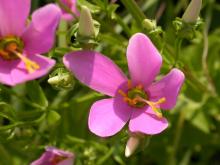Wildflowers, Grasses and Other Nonwoody Plants
Media

Species Types
Scientific Name
Oxalis violacea
Description
Missouri has one introduced and four native wood sorrels. Violet wood sorrel is the only one that has magenta or lavender flowers.
Media

Species Types
Scientific Name
Torilis arvensis
Description
Hedge parsley is an introduced plant that looks a lot like parsley. It was first collected in Missouri in 1909 and has become much more abundant in recent decades as it spreads along roadsides and railroads.
Media

Species Types
Scientific Name
Camassia scilloides
Description
In spring, wild hyacinth bears an elongated cluster of pale blue flowers with prominent anthers that sway on stalks up to 2 feet tall.
Media

Species Types
Scientific Name
Campanula americana
Description
Tall bellflower is an abundant native bellflower that is easily identified by its stout, tall habit, short, wheel-shaped, blue corolla, and the curved, purple style that projects beyond the flower.
Media

Species Types
Scientific Name
Fragaria virginiana
Description
Wild strawberry is one of the parents of the cultivated strawberry and is one of our prized native wild edibles. It’s also a valuable food for innumerable animals, and it’s attractive in native wildflower gardens.
Media

Species Types
Scientific Name
Sabatia angularis
Description
Rose-pink, or rose gentian, is a delicately scented native wildflower with floral clusters resembling candelabras. It has square stems and clasping leaves. It is common in open Ozark woods and fields and blooms June–September.
Media

Species Types
Scientific Name
Lactuca floridana
Description
A true lettuce that can be eaten as a cooked or salad green, Florida lettuce has lavender to purplish blue flowers and grows statewide.
Media

Species Types
Scientific Name
Dianthus armeria
Description
Deptford pink has straight, strong, narrow stems that bear small clusters of pink flowers with white dots. Common statewide in sunny, open locations such as pastures and roadsides.
Media

Species Types
Scientific Name
Triodanis perfoliata (formerly Specularia perfoliata)
Description
Clasping Venus' looking glass is a single-stemmed plant with purple or blue star-shaped flowers and bluntly toothed, alternate leaves that clasp the stem. It's scattered statewide in a variety of habitats and blooms May-June.
Media

Species Types
Scientific Name
Sisyrinchium campestre
Description
It has grasslike leaves, but it’s not a grass. In fact, it’s in the same family as the common garden iris! Four species of blue-eyed grass grow in Missouri, and this one, often found on prairies, glades, and pastures, is the most common.
See Also
About Wildflowers, Grasses and Other Nonwoody Plants in Missouri
A very simple way of thinking about the green world is to divide the vascular plants into two groups: woody and nonwoody (or herbaceous). But this is an artificial division; many plant families include some species that are woody and some that are not. The diversity of nonwoody vascular plants is staggering! Think of all the ferns, grasses, sedges, lilies, peas, sunflowers, nightshades, milkweeds, mustards, mints, and mallows — weeds and wildflowers — and many more!





















